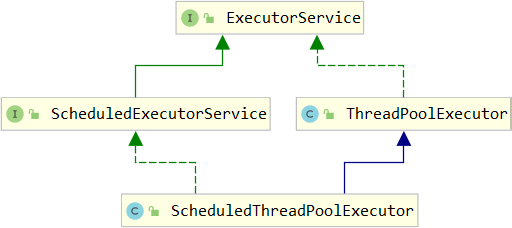线程池
自定义线程池
put
Thread Pool
Blocking Queue
t1
poll
t2
poll
task 1
task 2
task 3
t3
poll
main
步骤1:自定义拒绝策略接口


@FunctionalInterface // 拒绝策略
interface RejectPolicy
void reject(BlockingQueue
}
步骤2:自定义任务队列
class BlockingQueue
// 1. 任务队列
private Deque
// 2. 锁
private ReentrantLock lock = new ReentrantLock();
// 3. 生产者条件变量
private Condition fullWaitSet = lock.newCondition();
// 4. 消费者条件变量
private Condition emptyWaitSet = lock.newCondition();
// 5. 容 量
private int capcity;
public BlockingQueue(int capcity) { this.capcity = capcity;
}
// 带超时阻塞获取
public T poll(long timeout, TimeUnit unit) { lock.lock();
try {
// 将 timeout 统一转换为 纳秒
long nanos = unit.toNanos(timeout); while (queue.isEmpty()) {
try {
// 返回值是剩余时间
if (nanos <= 0) { return null;
}
nanos = emptyWaitSet.awaitNanos(nanos);
} catch (InterruptedException e) { e.printStackTrace();
}
}
T t = queue.removeFirst(); fullWaitSet.signal(); return t;
} finally {
lock.unlock();
} }
}
// 阻塞获取
public T take() { lock.lock(); try {
while (queue.isEmpty()) { try {
emptyWaitSet.await();
} catch (InterruptedException e) { e.printStackTrace();
}
}
T t = queue.removeFirst(); fullWaitSet.signal(); return t;
} finally {
lock.unlock();
}
}
// 阻塞添加
public void put(T task) { lock.lock();
try {
while (queue.size() == capcity) { try {
log.debug(“等待加入任务队列 {} …”, task);
fullWaitSet.await();
} catch (InterruptedException e) { e.printStackTrace();
}
}
log.debug(“加入任务队列 {}”, task); queue.addLast(task); emptyWaitSet.signal();
} finally {
lock.unlock();
}
}
// 带超时时间阻塞添加
public boolean offer(T task, long timeout, TimeUnit timeUnit) { lock.lock();
try {
long nanos = timeUnit.toNanos(timeout); while (queue.size() == capcity) {
try {
if(nanos <= 0) { return false;
}
log.debug(“等待加入任务队列 {} …”, task); nanos = fullWaitSet.awaitNanos(nanos);

} catch (InterruptedException e) { e.printStackTrace();
}
}
log.debug(“加入任务队列 {}”, task); queue.addLast(task); emptyWaitSet.signal();
return true;
} finally {
lock.unlock();
}
}
public int size() { lock.lock(); try {
return queue.size();
} finally {
lock.unlock();
}
}
public void tryPut(RejectPolicy
try {
// 判断队列是否满
if(queue.size() == capcity) { rejectPolicy.reject(this, task);
} else { // 有 空 闲
log.debug(“加入任务队列 {}”, task);
queue.addLast(task); emptyWaitSet.signal();
}
} finally {
lock.unlock();
}
}
}
步骤3:自定义线程池
class ThreadPool {
// 任务队列
private BlockingQueue
// 线程集合
private HashSet
// 核心线程数
private int coreSize;
// 获取任务时的超时时间
 private long timeout; private TimeUnit timeUnit;
private long timeout; private TimeUnit timeUnit;
private RejectPolicy
// 执行任务
public void execute(Runnable task) {
// 当任务数没有超过 coreSize 时,直接交给 worker 对象执行
// 如果任务数超过 coreSize 时,加入任务队列暂存
synchronized (workers) { if(workers.size() < coreSize) {
Worker worker = new Worker(task); log.debug(“新增 worker{}, {}”, worker, task); workers.add(worker);
worker.start();
} else {
// taskQueue.put(task);
// 1) 死 等
// 2) 带超时等待
// 3) 让调用者放弃任务执行
// 4) 让调用者抛出异常
// 5) 让调用者自己执行任务
taskQueue.tryPut(rejectPolicy, task);
}
}
}
public ThreadPool(int coreSize, long timeout, TimeUnit timeUnit, int queueCapcity, RejectPolicy
this.coreSize = coreSize; this.timeout = timeout; this.timeUnit = timeUnit;
this.taskQueue = new BlockingQueue<>(queueCapcity); this.rejectPolicy = rejectPolicy;
}
class Worker extends Thread{ private Runnable task;
public Worker(Runnable task) { this.task = task;
}
@Override
public void run() {
// 执行任务
// 1) 当 task 不为空,执行任务
// 2) 当 task 执行完毕,再接着从任务队列获取任务并执行
// while(task != null || (task = taskQueue.take()) != null) {
while(task != null || (task = taskQueue.poll(timeout, timeUnit)) != null) { try {
log.debug(“正在执行…{}”, task);

task.run();
} catch (Exception e) { e.printStackTrace();
} finally {
task = null;
}
}
synchronized (workers) { log.debug(“worker 被移除{}”, this); workers.remove(this);
}
}
}
}
步骤4:测试
public static void main(String[] args) { ThreadPool threadPool = new ThreadPool(1,
1000, TimeUnit.MILLISECONDS, 1, (queue, task)->{
// 1. 死 等
// queue.put(task);
// 2) 带超时等待
// queue.offer(task, 1500, TimeUnit.MILLISECONDS);
// 3) 让调用者放弃任务执行
// log.debug(“放弃{}”, task);
// 4) 让调用者抛出异常
// throw new RuntimeException(“任务执行失败 “ + task);
// 5) 让调用者自己执行任务
task.run();
});
for (int i = 0; i < 4; i++) { int j = i; threadPool.execute(() -> {
try {
Thread.sleep(1000L);
} catch (InterruptedException e) { e.printStackTrace();
}
log.debug(“{}”, j);
});
}
}
ThreadPoolExecutor



线程池状态
ThreadPoolExecutor 使用 int 的高 3 位来表示线程池状态,低 29 位表示线程数量
| 状态名 | 高 3 位 |
接收新任务 | 处理阻塞队列任务 | 说明 |
|---|---|---|---|---|
| RUNNING | 111 | Y | Y | |
| SHUTDOWN | 000 | N | Y | 不会接收新任务,但会处理阻塞队列剩余任务 |
| STOP | 001 | N | N | 会中断正在执行的任务,并抛弃阻塞队列任务 |
| TIDYING | 010 | - | - | 任务全执行完毕,活动线程为 0 即将进入终结 |
| TERMINATED | 011 | - | - | 终结状态 |
从数字上比较,TERMINATED > TIDYING > STOP > SHUTDOWN > RUNNING
这些信息存储在一个原子变量 ctl 中,目的是将线程池状态与线程个数合二为一,这样就可以用一次 cas 原子操作进行赋值
// c 为旧值, ctlOf 返回结果为新值
ctl.compareAndSet(c, ctlOf(targetState, workerCountOf(c))));
// rs 为高 3 位代表线程池状态, wc 为低 29 位代表线程个数,ctl 是合并它们
private static int ctlOf(int rs, int wc) { return rs | wc; }
构造方法


public ThreadPoolExecutor(int corePoolSize,
int maximumPoolSize, long keepAliveTime, TimeUnit unit,
BlockingQueue
corePoolSize 核心线程数目 (最多保留的线程数) maximumPoolSize 最大线程数目keepAliveTime 生存时间 - 针对救急线程
unit 时间单位 - 针对救急线程
workQueue 阻塞队列
threadFactory 线程工厂 - 可以为线程创建时起个好名字
handler 拒绝策略
工作方式:


线程池c=2,m=3
救急线程1
核心线程1
任务1
核心线程2
任务2
阻塞队列
任务3
任务4
size=2
线程池中刚开始没有线程,当一个任务提交给线程池后,线程池会创建一个新线程来执行任务。
当线程数达到 corePoolSize 并没有线程空闲,这时再加入任务,新加的任务会被加入workQueue 队列排队,直到有空闲的线程。
如果队列选择了有界队列,那么任务超过了队列大小时,会创建 maximumPoolSize - corePoolSize 数目的线程来救急。
如果线程到达 maximumPoolSize 仍然有新任务这时会执行拒绝策略。拒绝策略 jdk 提供了 4 种实现,其它著名框架也提供了实现
AbortPolicy 让调用者抛出 RejectedExecutionException 异常,这是默认策略


CallerRunsPolicy 让调用者运行任务
DiscardPolicy 放弃本次任务
DiscardOldestPolicy 放弃队列中最早的任务,本任务取而代之
Dubbo 的实现,在抛出 RejectedExecutionException 异常之前会记录日志,并 dump 线程栈信息,方便定位问题
Netty 的实现,是创建一个新线程来执行任务
ActiveMQ 的实现,带超时等待(60s)尝试放入队列,类似我们之前自定义的拒绝策略
PinPoint 的实现,它使用了一个拒绝策略链,会逐一尝试策略链中每种拒绝策略
当高峰过去后,超过corePoolSize 的救急线程如果一段时间没有任务做,需要结束节省资源,这个时间由
keepAliveTime 和 unit 来控制。
根据这个构造方法,JDK Executors 类中提供了众多工厂方法来创建各种用途的线程池
newFixedThreadPool
public static ExecutorService newFixedThreadPool(int nThreads) { return new ThreadPoolExecutor(nThreads, nThreads,
0L, TimeUnit.MILLISECONDS,
new LinkedBlockingQueue
}
特点
核心线程数 == 最大线程数(没有救急线程被创建),因此也无需超时时间阻塞队列是无界的,可以放任意数量的任务
评价 适用于任务量已知,相对耗时的任务
newCachedThreadPool
public static ExecutorService newCachedThreadPool() { return new ThreadPoolExecutor(0, Integer.MAX_VALUE,
60L, TimeUnit.SECONDS,
new SynchronousQueue
}
特点
核心线程数是 0, 最大线程数是 Integer.MAX_VALUE,救急线程的空闲生存时间是 60s,意味着全部都是救急线程(60s 后可以回收)


救急线程可以无限创建
队列采用了 SynchronousQueue 实现特点是,它没有容量,没有线程来取是放不进去的(一手交钱、一手交货)
SynchronousQueue
try {
log.debug(“putting {} “, 1); integers.put(1); log.debug(“{} putted…”, 1);
log.debug(“putting…{} “, 2); integers.put(2);
log.debug(“{} putted…”, 2);
} catch (InterruptedException e) { e.printStackTrace();
}
},”t1”).start(); sleep(1);
new Thread(() -> { try {
log.debug(“taking {}”, 1); integers.take();
} catch (InterruptedException e) { e.printStackTrace();
}
},”t2”).start(); sleep(1);
new Thread(() -> { try {
log.debug(“taking {}”, 2); integers.take();
} catch (InterruptedException e) { e.printStackTrace();
}
},”t3”).start();
输出
11:48:15.500 c.TestSynchronousQueue [t1] - putting 1
11:48:16.500 c.TestSynchronousQueue [t2] - taking 1
11:48:16.500 c.TestSynchronousQueue [t1] - 1 putted… 11:48:16.500 c.TestSynchronousQueue [t1] - putting…2 11:48:17.502 c.TestSynchronousQueue [t3] - taking 2
11:48:17.503 c.TestSynchronousQueue [t1] - 2 putted…


评价 整个线程池表现为线程数会根据任务量不断增长,没有上限,当任务执行完毕,空闲 1分钟后释放线程。 适合任务数比较密集,但每个任务执行时间较短的情况
newSingleThreadExecutor
public static ExecutorService newSingleThreadExecutor() { return new FinalizableDelegatedExecutorService
(new ThreadPoolExecutor(1, 1,
0L, TimeUnit.MILLISECONDS,
new LinkedBlockingQueue
}
使用场景:
希望多个任务排队执行。线程数固定为 1,任务数多于 1 时,会放入无界队列排队。任务执行完毕,这唯一的线程也不会被释放。
区别:
自己创建一个单线程串行执行任务,如果任务执行失败而终止那么没有任何补救措施,而线程池还会新建一 个线程,保证池的正常工作
Executors.newSingleThreadExecutor() 线程个数始终为1,不能修改
FinalizableDelegatedExecutorService 应用的是装饰器模式,只对外暴露了 ExecutorService 接口,因此不能调用 ThreadPoolExecutor 中特有的方法
Executors.newFixedThreadPool(1) 初始时为1,以后还可以修改
对外暴露的是 ThreadPoolExecutor 对象,可以强转后调用 setCorePoolSize 等方法进行修改
提交任务
// 执行任务
void execute(Runnable command);
// 提交任务 task,用返回值 Future 获得任务执行结果
// 提交 tasks 中所有任务
// 提交 tasks 中所有任务,带超时时间
long timeout, TimeUnit unit) throws InterruptedException;
// 提交 tasks 中所有任务,哪个任务先成功执行完毕,返回此任务执行结果,其它任务取消
throws InterruptedException, ExecutionException;


// 提交 tasks 中所有任务,哪个任务先成功执行完毕,返回此任务执行结果,其它任务取消,带超时时间
long timeout, TimeUnit unit)
throws InterruptedException, ExecutionException, TimeoutException;
/*
线程池状态变为 SHUTDOWN
- 不会接收新任务
- 但已提交任务会执行完
- 此方法不会阻塞调用线程的执行
*/
void shutdown();
public void shutdown() {
final ReentrantLock mainLock = this.mainLock; mainLock.lock();
try {
checkShutdownAccess();
// 修改线程池状态
advanceRunState(SHUTDOWN);
// 仅会打断空闲线程
interruptIdleWorkers();
onShutdown(); // 扩展点 ScheduledThreadPoolExecutor
} finally {
mainLock.unlock();
}
// 尝试终结(没有运行的线程可以立刻终结,如果还有运行的线程也不会等) tryTerminate();
}
shutdownNow
/*
线程池状态变为 STOP
- 不会接收新任务
- 会将队列中的任务返回
- 并用 interrupt 的方式中断正在执行的任务
*/
List
public List


List
final ReentrantLock mainLock = this.mainLock; mainLock.lock();
try {
checkShutdownAccess();
// 修改线程池状态
advanceRunState(STOP);
// 打断所有线程
interruptWorkers();
// 获取队列中剩余任务
tasks = drainQueue();
} finally {
mainLock.unlock();
}
// 尝试终结tryTerminate(); return tasks;
}
其它方法
// 不在 RUNNING 状态的线程池,此方法就返回 true boolean isShutdown();
// 线程池状态是否是 TERMINATED boolean isTerminated();
// 调用 shutdown 后,由于调用线程并不会等待所有任务运行结束,因此如果它想在线程池 TERMINATED 后做些事情,可以利用此方法等待
boolean awaitTermination(long timeout, TimeUnit unit) throws InterruptedException;
- 模式之 Worker Thread
任务调度线程池
在『任务调度线程池』功能加入之前,可以使用 java.util.Timer 来实现定时功能,Timer 的优点在于简单易用,但由于所有任务都是由同一个线程来调度,因此所有任务都是串行执行的,同一时间只能有一个任务在执行,前一个 任务的延迟或异常都将会影响到之后的任务。
public static void main(String[] args) { Timer timer = new Timer();
TimerTask task1 = new TimerTask() { @Override
public void run() { log.debug(“task 1”);
sleep(2);


}
};
TimerTask task2 = new TimerTask() { @Override
public void run() { log.debug(“task 2”);
}
};
// 使用 timer 添加两个任务,希望它们都在 1s 后执行
// 但由于 timer 内只有一个线程来顺序执行队列中的任务,因此『任务1』的延时,影响了『任务2』的执行
timer.schedule(task1, 1000);
timer.schedule(task2, 1000);
}
输出
20:46:09.444 c.TestTimer [main] - start… 20:46:10.447 c.TestTimer [Timer-0] - task 1
20:46:12.448 c.TestTimer [Timer-0] - task 2
使用 ScheduledExecutorService 改写:
ScheduledExecutorService executor = Executors.newScheduledThreadPool(2);
// 添加两个任务,希望它们都在 1s 后执行
executor.schedule(() -> {
System.out.println(“任务1,执行时间:” + new Date());
try { Thread.sleep(2000); } catch (InterruptedException e) { }
}, 1000, TimeUnit.MILLISECONDS);
executor.schedule(() -> {
System.out.println(“任务2,执行时间:” + new Date());
}, 1000, TimeUnit.MILLISECONDS);
输出
任务1,执行时间:Thu Jan 03 12:45:17 CST 2019
任务2,执行时间:Thu Jan 03 12:45:17 CST 2019
scheduleAtFixedRate 例子:
ScheduledExecutorService pool = Executors.newScheduledThreadPool(1); log.debug(“start…”);
pool.scheduleAtFixedRate(() -> { log.debug(“running…”);
}, 1, 1, TimeUnit.SECONDS);
输出


21:45:43.167 c.TestTimer [main] - start…
21:45:44.215 c.TestTimer [pool-1-thread-1] - running… 21:45:45.215 c.TestTimer [pool-1-thread-1] - running… 21:45:46.215 c.TestTimer [pool-1-thread-1] - running… 21:45:47.215 c.TestTimer [pool-1-thread-1] - running…
scheduleAtFixedRate 例子(任务执行时间超过了间隔时间):
ScheduledExecutorService pool = Executors.newScheduledThreadPool(1); log.debug(“start…”);
pool.scheduleAtFixedRate(() -> { log.debug(“running…”); sleep(2);
}, 1, 1, TimeUnit.SECONDS);
输出分析:一开始,延时 1s,接下来,由于任务执行时间 > 间隔时间,间隔被『撑』到了 2s
21:44:30.311 c.TestTimer [main] - start…
21:44:31.360 c.TestTimer [pool-1-thread-1] - running… 21:44:33.361 c.TestTimer [pool-1-thread-1] - running… 21:44:35.362 c.TestTimer [pool-1-thread-1] - running… 21:44:37.362 c.TestTimer [pool-1-thread-1] - running…
scheduleWithFixedDelay 例子:
ScheduledExecutorService pool = Executors.newScheduledThreadPool(1); log.debug(“start…”);
pool.scheduleWithFixedDelay(()-> { log.debug(“running…”); sleep(2);
}, 1, 1, TimeUnit.SECONDS);
输出分析:一开始,延时 1s,scheduleWithFixedDelay 的间隔是 所以间隔都是 3s
上一个任务结束 <-> 延时 <-> 下一个任务开始
21:40:55.078 c.TestTimer [main] - start…
21:40:56.140 c.TestTimer [pool-1-thread-1] - running… 21:40:59.143 c.TestTimer [pool-1-thread-1] - running… 21:41:02.145 c.TestTimer [pool-1-thread-1] - running… 21:41:05.147 c.TestTimer [pool-1-thread-1] - running…
评价 整个线程池表现为:线程数固定,任务数多于线程数时,会放入无界队列排队。任务执行完毕,这些线程也不会被释放。用来执行延迟或反复执行的任务
- 正确处理执行任务异常方法1:主动捉异常


ExecutorService pool = Executors.newFixedThreadPool(1); pool.submit(() -> {
try {
log.debug(“task1”); int i = 1 / 0;
} catch (Exception e) { log.error(“error:”, e);
}
});
输出
21:59:04.558 c.TestTimer [pool-1-thread-1] - task1 21:59:04.562 c.TestTimer [pool-1-thread-1] - error: java.lang.ArithmeticException: / by zero
at cn.itcast.n8.TestTimer.lambda$main$0(TestTimer.java:28)
at java.util.concurrent.Executors$RunnableAdapter.call(Executors.java:511) at java.util.concurrent.FutureTask.run(FutureTask.java:266)
at java.util.concurrent.ThreadPoolExecutor.runWorker(ThreadPoolExecutor.java:1149) at java.util.concurrent.ThreadPoolExecutor$Worker.run(ThreadPoolExecutor.java:624) at java.lang.Thread.run(Thread.java:748)
方法2:使用 Future
ExecutorService pool = Executors.newFixedThreadPool(1); Future
log.debug(“task1”); int i = 1 / 0; return true;
});
log.debug(“result:{}”, f.get());
输出
21:54:58.208 c.TestTimer [pool-1-thread-1] - task1
Exception in thread “main” java.util.concurrent.ExecutionException: java.lang.ArithmeticException: / by zero
at java.util.concurrent.FutureTask.report(FutureTask.java:122) at java.util.concurrent.FutureTask.get(FutureTask.java:192)
at cn.itcast.n8.TestTimer.main(TestTimer.java:31)
Caused by: java.lang.ArithmeticException: / by zero
at cn.itcast.n8.TestTimer.lambda$main$0(TestTimer.java:28) at java.util.concurrent.FutureTask.run(FutureTask.java:266)
at java.util.concurrent.ThreadPoolExecutor.runWorker(ThreadPoolExecutor.java:1149) at java.util.concurrent.ThreadPoolExecutor$Worker.run(ThreadPoolExecutor.java:624) at java.lang.Thread.run(Thread.java:748)


应用之定时任务
- Tomcat 线程池
Tomcat 在哪里用到了线程池呢
LimitLatch 用来限流,可以控制最大连接个数,类似 J.U.C 中的 Semaphore 后面再讲
Acceptor 只负责【接收新的 socket 连接】
Poller 只负责监听 socket channel 是否有【可读的 I/O 事件】
一旦可读,封装一个任务对象(socketProcessor),提交给 Executor 线程池处理
Executor 线程池中的工作线程最终负责【处理请求】
Tomcat 线程池扩展了 ThreadPoolExecutor,行为稍有不同如果总线程数达到 maximumPoolSize
这时不会立刻抛 RejectedExecutionException 异常
而是再次尝试将任务放入队列,如果还失败,才抛出 RejectedExecutionException 异常
源码 tomcat-7.0.42
public void execute(Runnable command, long timeout, TimeUnit unit) { submittedCount.incrementAndGet();
try {
super.execute(command);
} catch (RejectedExecutionException rx) {
if (super.getQueue() instanceof TaskQueue) {
final TaskQueue queue = (TaskQueue)super.getQueue(); try {
if (!queue.force(command, timeout, unit)) { submittedCount.decrementAndGet();
throw new RejectedExecutionException(“Queue capacity is full.”);
}
} catch (InterruptedException x) { submittedCount.decrementAndGet(); Thread.interrupted();
throw new RejectedExecutionException(x);
}


} else {
submittedCount.decrementAndGet(); throw rx;
}
}
}
TaskQueue.java
public boolean force(Runnable o, long timeout, TimeUnit unit) throws InterruptedException { if ( parent.isShutdown() )
throw new RejectedExecutionException(
“Executor not running, can’t force a command into the queue”
);
return super.offer(o,timeout,unit); //forces the item onto the queue, to be used if the task is rejected
}
Connector 配置
| 配置项 | 默认值 | 说明 |
|---|---|---|
| acceptorThreadCount | 1 | acceptor 线程数量 |
| pollerThreadCount | 1 | poller 线程数量 |
| minSpareThreads | 10 | 核心线程数,即 corePoolSize |
| maxThreads | 200 | 最大线程数,即 maximumPoolSize |
| executor | - | Executor 名称,用来引用下面的 Executor |
Executor 线程配置


| 配置项 | 默认值 | 说明 |
|---|---|---|
| threadPriority | 5 | 线程优先级 |
| daemon | true | 是否守护线程 |
| minSpareThreads | 25 | 核心线程数,即 corePoolSize |
| maxThreads | 200 | 最大线程数,即 maximumPoolSize |
| maxIdleTime | 60000 | 线程生存时间,单位是毫秒,默认值即 1 分钟 |
| maxQueueSize | Integer.MAX_VALUE | 队列长度 |
| prestartminSpareThreads | false | 核心线程是否在服务器启动时启动 |
是
加入队列
添加新任务
否
否
是
创建救急线程
提交任务 < 核心线程
提交任务 < 最大线程
Fork/Join
概念
Fork/Join 是 JDK 1.7 加入的新的线程池实现,它体现的是一种分治思想,适用于能够进行任务拆分的 cpu 密集型运算
所谓的任务拆分,是将一个大任务拆分为算法上相同的小任务,直至不能拆分可以直接求解。跟递归相关的一些计 算,如归并排序、斐波那契数列、都可以用分治思想进行求解
Fork/Join 在分治的基础上加入了多线程,可以把每个任务的分解和合并交给不同的线程来完成,进一步提升了运算效率
Fork/Join 默认会创建与 cpu 核心数大小相同的线程池
使用
提交给 Fork/Join 线程池的任务需要继承 RecursiveTask(有返回值)或 RecursiveAction(没有返回值),例如下面定义了一个对 1~n 之间的整数求和的任务
@Slf4j(topic = “c.AddTask”)


class AddTask1 extends RecursiveTask
public AddTask1(int n) { this.n = n;
}
@Override
public String toString() { return “{“ + n + ‘}’;
}
@Override
protected Integer compute() {
// 如果 n 已经为 1,可以求得结果了if (n == 1) {
log.debug(“join() {}”, n); return n;
}
// 将任务进行拆分(fork)
AddTask1 t1 = new AddTask1(n - 1); t1.fork();
log.debug(“fork() {} + {}”, n, t1);
// 合并(join)结果
int result = n + t1.join();
log.debug(“join() {} + {} = {}”, n, t1, result); return result;
}
}
然后提交给 ForkJoinPool 来执行
public static void main(String[] args) { ForkJoinPool pool = new ForkJoinPool(4); System.out.println(pool.invoke(new AddTask1(5)));
}
结果


[ForkJoinPool-1-worker-0] - fork() 2 + {1}
[ForkJoinPool-1-worker-1] - fork() 5 + {4} [ForkJoinPool-1-worker-0] - join() 1 [ForkJoinPool-1-worker-0] - join() 2 + {1} = 3
[ForkJoinPool-1-worker-2] - fork() 4 + {3}
[ForkJoinPool-1-worker-3] - fork() 3 + {2}
[ForkJoinPool-1-worker-3] - join() 3 + {2} = 6
[ForkJoinPool-1-worker-2] - join() 4 + {3} = 10
[ForkJoinPool-1-worker-1] - join() 5 + {4} = 15
15
用图来表示
{4}
{3}
{2}
{1}
t2 4 + {3} t3 3 + {2} t0 2 + {1} t0
t1 5 + {4}
10
6
3
1
15
结果
改进
class AddTask3 extends RecursiveTask
int begin; int end;
public AddTask3(int begin, int end) { this.begin = begin;
this.end = end;
}
@Override
public String toString() {
return “{“ + begin + “,” + end + ‘}’;
}
@Override
protected Integer compute() {
// 5, 5
if (begin == end) { log.debug(“join() {}”, begin); return begin;
}
// 4, 5


if (end - begin == 1) {
log.debug(“join() {} + {} = {}”, begin, end, end + begin); return end + begin;
}
// 1 5
int mid = (end + begin) / 2; // 3
AddTask3 t1 = new AddTask3(begin, mid); // 1,3 t1.fork();
AddTask3 t2 = new AddTask3(mid + 1, end); // 4,5 t2.fork();
log.debug(“fork() {} + {} = ?”, t1, t2);
int result = t1.join() + t2.join(); log.debug(“join() {} + {} = {}”, t1, t2, result); return result;
}
}
然后提交给 ForkJoinPool 来执行
public static void main(String[] args) { ForkJoinPool pool = new ForkJoinPool(4);
System.out.println(pool.invoke(new AddTask3(1, 10)));
}
结果
[ForkJoinPool-1-worker-0] - join() 1 + 2 = 3
[ForkJoinPool-1-worker-3] - join() 4 + 5 = 9 [ForkJoinPool-1-worker-0] - join() 3
[ForkJoinPool-1-worker-1] - fork() {1,3} + {4,5} = ?
[ForkJoinPool-1-worker-2] - fork() {1,2} + {3,3} = ?
[ForkJoinPool-1-worker-2] - join() {1,2} + {3,3} = 6
[ForkJoinPool-1-worker-1] - join() {1,3} + {4,5} = 15
15
用图来表示

{3,3}
{1,3}
{1,2}
6
t0
3
{4,5}
t3
3
9
15
结果
t1 {1,3} + {4,5}
t2 {1,2} + {3,3}
J.U.C
* AQS 原理
让 可以并发,提高性能。 类似于数据库中的
读写锁
读-读
select …
read()
write()
from … lock in share mode
提供一个
数据容器类
内部分别使用读锁保护数据的
方法,写锁保护数据的 方法

class DataContainer { private Object data;
private ReentrantReadWriteLock rw = new ReentrantReadWriteLock(); private ReentrantReadWriteLock.ReadLock r = rw.readLock(); private ReentrantReadWriteLock.WriteLock w = rw.writeLock();
public Object read() { log.debug(“获取读锁…”); r.lock();
try {
log.debug(“读取”); sleep(1);
return data;
} finally {
log.debug(“释放读锁…”);


r.unlock();
}
}
public void write() { log.debug(“获取写锁…”); w.lock();
try {
log.debug(“写入”); sleep(1);
} finally {
log.debug(“释放写锁…”); w.unlock();
}
}
}
测试 可以并发
读锁-读锁
DataContainer dataContainer = new DataContainer(); new Thread(() -> {
dataContainer.read();
}, “t1”).start();
new Thread(() -> { dataContainer.read();
}, “t2”).start();
输出结果,从这里可以看到 Thread-0 锁定期间,Thread-1 的读操作不受影响
14:05:14.341 c.DataContainer [t2] - 获取读锁… 14:05:14.341 c.DataContainer [t1] - 获取读锁… 14:05:14.345 c.DataContainer [t1] - 读取14:05:14.345 c.DataContainer [t2] - 读取14:05:15.365 c.DataContainer [t2] - 释放读锁… 14:05:15.386 c.DataContainer [t1] - 释放读锁…
测试 相互阻塞
读锁-写锁
DataContainer dataContainer = new DataContainer(); new Thread(() -> {
dataContainer.read();
}, “t1”).start();
Thread.sleep(100); new Thread(() -> {
dataContainer.write();
}, “t2”).start();
输出结果


14:04:21.838 c.DataContainer [t1] - 获取读锁… 14:04:21.838 c.DataContainer [t2] - 获取写锁… 14:04:21.841 c.DataContainer [t2] - 写入14:04:22.843 c.DataContainer [t2] - 释放写锁… 14:04:22.843 c.DataContainer [t1] - 读取14:04:23.843 c.DataContainer [t1] - 释放读锁…
也是相互阻塞的,这里就不测试了
写锁-写锁
注意事项
读锁不支持条件变量
重入时升级不支持:即持有读锁的情况下去获取写锁,会导致获取写锁永久等待
r.lock(); try {
// …
w.lock(); try {
// …
} finally{
w.unlock();
}
} finally{ r.unlock();
}
重入时降级支持:即持有写锁的情况下去获取读锁
class CachedData { Object data;
// 是否有效,如果失效,需要重新计算 data
volatile boolean cacheValid;
final ReentrantReadWriteLock rwl = new ReentrantReadWriteLock(); void processCachedData() {
rwl.readLock().lock(); if (!cacheValid) {
// 获取写锁前必须释放读锁
rwl.readLock().unlock(); rwl.writeLock().lock(); try {
// 判断是否有其它线程已经获取了写锁、更新了缓存, 避免重复更新
if (!cacheValid) { data = … cacheValid = true;
}
// 降级为读锁, 释放写锁, 这样能够让其它线程读取缓存
rwl.readLock().lock();
} finally {
应用之缓存
- 读写锁原理
StampedLock
该类自 JDK 8 加入,是为了进一步优化读性能,它的特点是在使用读锁、写锁时都必须配合【戳】使用加解读锁
long stamp = lock.readLock(); lock.unlockRead(stamp);
加解写锁
long stamp = lock.writeLock(); lock.unlockWrite(stamp);
乐观读,StampedLock 支持
tryOptimisticRead()
戳校验
方法(乐观读),读取完毕后需要做一次
如果校验通
 过,表示这期间确实没有写操作,数据可以安全使用,如果校验没通过,需要重新获取读锁,保证数据安全。
过,表示这期间确实没有写操作,数据可以安全使用,如果校验没通过,需要重新获取读锁,保证数据安全。
rwl.writeLock().unlock();
}
}
// 自己用完数据, 释放读锁
try {
use(data);
} finally { rwl.readLock().unlock();
}
}
}
long stamp = lock.tryOptimisticRead();
// 验 戳
if(!lock.validate(stamp)){
// 锁升级
}
提供一个 数据容器类 内部分别使用读锁保护数据的 方法,写锁保护数据的 方法
read()
write()
class DataContainerStamped {
private int data;


private final StampedLock lock = new StampedLock();
public DataContainerStamped(int data) { this.data = data;
}
public int read(int readTime) {
long stamp = lock.tryOptimisticRead(); log.debug(“optimistic read locking…{}”, stamp); sleep(readTime);
if (lock.validate(stamp)) {
log.debug(“read finish…{}, data:{}”, stamp, data); return data;
}
// 锁升级 - 读锁
log.debug(“updating to read lock… {}”, stamp); try {
stamp = lock.readLock(); log.debug(“read lock {}”, stamp); sleep(readTime);
log.debug(“read finish…{}, data:{}”, stamp, data); return data;
} finally {
log.debug(“read unlock {}”, stamp); lock.unlockRead(stamp);
}
}
public void write(int newData) { long stamp = lock.writeLock();
log.debug(“write lock {}”, stamp); try {
sleep(2);
this.data = newData;
} finally {
log.debug(“write unlock {}”, stamp); lock.unlockWrite(stamp);
}
}
}
测试 可以优化
读-读


public static void main(String[] args) {
DataContainerStamped dataContainer = new DataContainerStamped(1); new Thread(() -> {
dataContainer.read(1);
}, “t1”).start(); sleep(0.5);
new Thread(() -> { dataContainer.read(0);
}, “t2”).start();
}
输出结果,可以看到实际没有加读锁
15:58:50.217 c.DataContainerStamped [t1] - optimistic read locking…256 15:58:50.717 c.DataContainerStamped [t2] - optimistic read locking…256 15:58:50.717 c.DataContainerStamped [t2] - read finish…256, data:1 15:58:51.220 c.DataContainerStamped [t1] - read finish…256, data:1
测试 时优化读补加读锁
读-写
public static void main(String[] args) {
DataContainerStamped dataContainer = new DataContainerStamped(1); new Thread(() -> {
dataContainer.read(1);
}, “t1”).start(); sleep(0.5);
new Thread(() -> { dataContainer.write(100);
}, “t2”).start();
}
输出结果
15:57:00.219 c.DataContainerStamped [t1] - optimistic read locking…256 15:57:00.717 c.DataContainerStamped [t2] - write lock 384
15:57:01.225 c.DataContainerStamped [t1] - updating to read lock… 256 15:57:02.719 c.DataContainerStamped [t2] - write unlock 384 15:57:02.719 c.DataContainerStamped [t1] - read lock 513
15:57:03.719 c.DataContainerStamped [t1] - read finish…513, data:1000 15:57:03.719 c.DataContainerStamped [t1] - read unlock 513
注意
StampedLock 不支持条件变量
StampedLock 不支持可重入
Semaphore
基本使用


[ˈsɛməˌfɔr] 信号量,用来限制能同时访问共享资源的线程上限。
public static void main(String[] args) {
// 1. 创建 semaphore 对象
Semaphore semaphore = new Semaphore(3);
// 2. 10个线程同时运行
for (int i = 0; i < 10; i++) { new Thread(() -> {
// 3. 获取许可
try {
semaphore.acquire();
} catch (InterruptedException e) { e.printStackTrace();
}
try {
log.debug(“running…”); sleep(1); log.debug(“end…”);
} finally {
// 4. 释放许可
semaphore.release();
}
}).start();
}
}
输出
07:35:15.485 c.TestSemaphore [Thread-2] - running… 07:35:15.485 c.TestSemaphore [Thread-1] - running… 07:35:15.485 c.TestSemaphore [Thread-0] - running… 07:35:16.490 c.TestSemaphore [Thread-2] - end…
07:35:16.490 c.TestSemaphore [Thread-0] - end… 07:35:16.490 c.TestSemaphore [Thread-1] - end… 07:35:16.490 c.TestSemaphore [Thread-3] - running… 07:35:16.490 c.TestSemaphore [Thread-5] - running… 07:35:16.490 c.TestSemaphore [Thread-4] - running… 07:35:17.490 c.TestSemaphore [Thread-5] - end…
07:35:17.490 c.TestSemaphore [Thread-4] - end… 07:35:17.490 c.TestSemaphore [Thread-3] - end… 07:35:17.490 c.TestSemaphore [Thread-6] - running… 07:35:17.490 c.TestSemaphore [Thread-7] - running… 07:35:17.490 c.TestSemaphore [Thread-9] - running… 07:35:18.491 c.TestSemaphore [Thread-6] - end…
07:35:18.491 c.TestSemaphore [Thread-7] - end… 07:35:18.491 c.TestSemaphore [Thread-9] - end… 07:35:18.491 c.TestSemaphore [Thread-8] - running… 07:35:19.492 c.TestSemaphore [Thread-8] - end…


Semaphore 应用
- Semaphore 原理
CountdownLatch
用来进行线程同步协作,等待所有线程完成倒计时。
其中构造参数用来初始化等待计数值,await() 用来等待计数归零,countDown() 用来让计数减一
public static void main(String[] args) throws InterruptedException { CountDownLatch latch = new CountDownLatch(3);
new Thread(() -> { log.debug(“begin…”); sleep(1); latch.countDown();
log.debug(“end…{}”, latch.getCount());
}).start();
new Thread(() -> { log.debug(“begin…”); sleep(2); latch.countDown();
log.debug(“end…{}”, latch.getCount());
}).start();
new Thread(() -> { log.debug(“begin…”); sleep(1.5); latch.countDown();
log.debug(“end…{}”, latch.getCount());
}).start();
log.debug(“waiting…”); latch.await(); log.debug(“wait end…”);
}
输出
18:44:00.778 c.TestCountDownLatch [main] - waiting… 18:44:00.778 c.TestCountDownLatch [Thread-2] - begin… 18:44:00.778 c.TestCountDownLatch [Thread-0] - begin… 18:44:00.778 c.TestCountDownLatch [Thread-1] - begin… 18:44:01.782 c.TestCountDownLatch [Thread-0] - end…2 18:44:02.283 c.TestCountDownLatch [Thread-2] - end…1 18:44:02.782 c.TestCountDownLatch [Thread-1] - end…0 18:44:02.782 c.TestCountDownLatch [main] - wait end…


可以配合线程池使用,改进如下
public static void main(String[] args) throws InterruptedException { CountDownLatch latch = new CountDownLatch(3);
ExecutorService service = Executors.newFixedThreadPool(4); service.submit(() -> {
log.debug(“begin…”); sleep(1); latch.countDown();
log.debug(“end…{}”, latch.getCount());
});
service.submit(() -> { log.debug(“begin…”); sleep(1.5); latch.countDown();
log.debug(“end…{}”, latch.getCount());
});
service.submit(() -> { log.debug(“begin…”); sleep(2); latch.countDown();
log.debug(“end…{}”, latch.getCount());
});
service.submit(()->{ try {
log.debug(“waiting…”); latch.await(); log.debug(“wait end…”);
} catch (InterruptedException e) { e.printStackTrace();
}
});
}
输出
18:52:25.831 c.TestCountDownLatch [pool-1-thread-3] - begin… 18:52:25.831 c.TestCountDownLatch [pool-1-thread-1] - begin… 18:52:25.831 c.TestCountDownLatch [pool-1-thread-2] - begin… 18:52:25.831 c.TestCountDownLatch [pool-1-thread-4] - waiting… 18:52:26.835 c.TestCountDownLatch [pool-1-thread-1] - end…2 18:52:27.335 c.TestCountDownLatch [pool-1-thread-2] - end…1 18:52:27.835 c.TestCountDownLatch [pool-1-thread-3] - end…0 18:52:27.835 c.TestCountDownLatch [pool-1-thread-4] - wait end…
应用之同步等待多线程准备完毕
AtomicInteger num = new AtomicInteger(0);
ExecutorService service = Executors.newFixedThreadPool(10, (r) -> {


return new Thread(r, “t” + num.getAndIncrement());
});
CountDownLatch latch = new CountDownLatch(10); String[] all = new String[10];
Random r = new Random();
for (int j = 0; j < 10; j++) { int x = j; service.submit(() -> {
for (int i = 0; i <= 100; i++) { try {
Thread.sleep(r.nextInt(100));
} catch (InterruptedException e) {
}
all[x] = Thread.currentThread().getName() + “(“ + (i + “%”) + “)”; System.out.print(“\r” + Arrays.toString(all));
}
latch.countDown();
});
}
latch.await(); System.out.println(“\n游戏开始…”); service.shutdown();
中间输出
[t0(52%), t1(47%), t2(51%), t3(40%), t4(49%), t5(44%), t6(49%), t7(52%), t8(46%), t9(46%)]
最后输出
[t0(100%), t1(100%), t2(100%), t3(100%), t4(100%), t5(100%), t6(100%), t7(100%), t8(100%), t9(100%)]
游戏开始…
应用之同步等待多个远程调用结束
@RestController
public class TestCountDownlatchController {
@GetMapping(“/order/{id}”)
public Map
map.put(“total”, “2300.00”); sleep(2000);
return map;
}
@GetMapping(“/product/{id}”)
public Map


HashMap
map.put(“name”, “小爱音箱”);
map.put(“price”, 300);
} else if (id == 2) { map.put(“name”, “小米手机”);
map.put(“price”, 2000);
}
map.put(“id”, id); sleep(1000); return map;
}
@GetMapping(“/logistics/{id}”)
public Map
map.put(“name”, “中通快递”);
sleep(2500); return map;
}
private void sleep(int millis) { try {
Thread.sleep(millis);
} catch (InterruptedException e) { e.printStackTrace();
}
}
}
rest 远程调用
RestTemplate restTemplate = new RestTemplate(); log.debug(“begin”);
ExecutorService service = Executors.newCachedThreadPool(); CountDownLatch latch = new CountDownLatch(4); Future
Map
return r;
});
Future
restTemplate.getForObject(“http://localhost:8080/product/{1}“, Map.class, 1); return r;
});
Future
restTemplate.getForObject(“http://localhost:8080/product/{1}“, Map.class, 2); return r;
});


Future
restTemplate.getForObject(“http://localhost:8080/logistics/{1}“, Map.class, 1); return r;
});
System.out.println(f1.get()); System.out.println(f2.get()); System.out.println(f3.get()); System.out.println(f4.get()); log.debug(“ 执 行 完 毕 “); service.shutdown();
执行结果
19:51:39.711 c.TestCountDownLatch [main] - begin
{total=2300.00, id=1}
{price=300, name=小爱音箱, id=1}
{price=2000, name=小米手机, id=2}
{name=中通快递, id=1}
19:51:42.407 c.TestCountDownLatch [main] - 执行完毕
CyclicBarrier
[ˈsaɪklɪk ˈbæriɚ] 循环栅栏,用来进行线程协作,等待线程满足某个计数。构造时设置『计数个数』,每个线程执行到某个需要“同步”的时刻调用 await() 方法进行等待,当等待的线程数满足『计数个数』时,继续执行
CyclicBarrier cb = new CyclicBarrier(2); // 个数为2时才会继续执行
new Thread(()->{
System.out.println(“线程1开始..”+new Date()); try {
cb.await(); // 当个数不足时,等待
} catch (InterruptedException | BrokenBarrierException e) { e.printStackTrace();
}
System.out.println(“线程1继续向下运行…”+new Date());
}).start();
new Thread(()->{
System.out.println(“线程2开始..”+new Date());
try { Thread.sleep(2000); } catch (InterruptedException e) { } try {
cb.await(); // 2 秒后,线程个数够2,继续运行
} catch (InterruptedException | BrokenBarrierException e) { e.printStackTrace();
}
System.out.println(“线程2继续向下运行…”+new Date());
}).start();


注意 CyclicBarrier 与 CountDownLatch 的主要区别在于 CyclicBarrier 是可以重用的 CyclicBarrier 可以被比喻为『人满发车』
线程安全集合类概述
遗留的安全集合
Vector
Hashtable
修饰的安全集合
使用Collections的方法修饰 使用Collections的方法修饰
SynchronizedList
SynchronizedMap
J.U.C 安全集合
CopyOnWrite类
Concurrent类
Blocking类
线程安全集合类可以分为三大类:
遗留的线程安全集合如 ,
Hashtable
Vector
使用 Collections 装饰的线程安全集合,如:
Collections.synchronizedNavigableMap Collections.synchronizedNavigableSet
Collections.synchronizedSortedSet
Collections.synchronizedSortedMap
| Collections.synchronizedCollection | ||
|---|---|---|
| Collections.synchronizedList | ||
| Collections.synchronizedMap | ||
| Collections.synchronizedSet |
java.util.concurrent.*
重点介绍 下的线程安全集合类,可以发现它们有规律,里面包含三类关键词:
Blocking、CopyOnWrite、Concurrent
java.util.concurrent.
Blocking 大部分实现基于锁,并提供用来阻塞的方法CopyOnWrite 之类容器修改开销相对较重Concurrent 类型的容器
内部很多操作使用 cas 优化,一般可以提供较高吞吐量弱一致性
遍历时弱一致性,例如,当利用迭代器遍历时,如果容器发生修改,迭代器仍然可以继续进行遍 历,这时内容是旧的
求大小弱一致性,size 操作未必是 100% 准确读取弱一致性
遍历时如果发生了修改,对于非安全容器来讲,使用 *fail-fast 机制也就是让遍历立刻失败,抛出
ConcurrentModificationException,不再继续遍历


ConcurrentHashMap
练习:单词计数生成测试数据
static final String ALPHA = “abcedfghijklmnopqrstuvwxyz”;
public static void main(String[] args) { int length = ALPHA.length();
int count = 200;
List
char ch = ALPHA.charAt(i);
for (int j = 0; j < count; j++) { list.add(String.valueOf(ch));
}
}
Collections.shuffle(list); for (int i = 0; i < 26; i++) {
try (PrintWriter out = new PrintWriter( new OutputStreamWriter(
new FileOutputStream(“tmp/“ + (i+1) + “.txt”)))) {
String collect = list.subList(i count, (i + 1) * count).stream()
.collect(Collectors.joining(“\n”)); out.print(collect);
} catch (IOException e) {
}
}
}
模版代码,模版代码中封装了多线程读取文件的代码
private static
Map
for (int i = 1; i <= 26; i++) { int idx = i;
Thread thread = new Thread(() -> { List
});
ts.add(thread);
}
ts.forEach(t->t.start()); ts.forEach(t-> {
try {
t.join();
} catch (InterruptedException e) {
e.printStackTrace();


}
});
System.out.println(counterMap);
}
public static List
try (BufferedReader in = new BufferedReader(new InputStreamReader(new FileInputStream(“tmp/“
+ i +”.txt”)))) {
while(true) {
String word = in.readLine(); if(word == null) {
break;
}
words.add(word);
}
return words;
} catch (IOException e) {
throw new RuntimeException(e);
}
}
你要做的是实现两个参数
一是提供一个 map 集合,用来存放每个单词的计数结果,key 为单词,value 为计数二是提供一组操作,保证计数的安全性,会传递 map 集合以及 单词 List
正确结果输出应该是每个单词出现 200 次
{a=200, b=200, c=200, d=200, e=200, f=200, g=200, h=200, i=200, j=200, k=200, l=200, m=200, n=200, o=200, p=200, q=200, r=200, s=200, t=200, u=200, v=200, w=200, x=200, y=200, z=200}
下面的实现为:
demo(
// 创 建 map 集 合
// 创建 ConcurrentHashMap 对不对?
() -> new HashMap
// 进行计数
(map, words) -> {
for (String word : words) {
Integer counter = map.get(word);
int newValue = counter == null ? 1 : counter + 1; map.put(word, newValue);
}
}
);
有没有问题?请改进


参考解答1
demo(
() -> new ConcurrentHashMap
for (String word : words) {
// 注意不能使用 putIfAbsent,此方法返回的是上一次的 value,首次调用返回 null map.computeIfAbsent(word, (key) -> new LongAdder()).increment();
}
}
);
参考解答2
demo(
() -> new ConcurrentHashMap
for (String word : words) {
// 函数式编程,无需原子变量
map.merge(word, 1, Integer::sum);
}
}
);
ConcurrentLinkedQueue
ConcurrentLinkedQueue 的设计与 LinkedBlockingQueue 非常像,也是
两把【锁】,同一时刻,可以允许两个线程同时(一个生产者与一个消费者)执行
dummy 节点的引入让两把【锁】将来锁住的是不同对象,避免竞争只是这【锁】使用了 cas 来实现
事实上,ConcurrentLinkedQueue 应用还是非常广泛的
例如之前讲的 Tomcat 的 Connector 结构时,Acceptor 作为生产者向 Poller 消费者传递事件信息时,正是采用了
ConcurrentLinkedQueue 将 SocketChannel 给 Poller 使用

